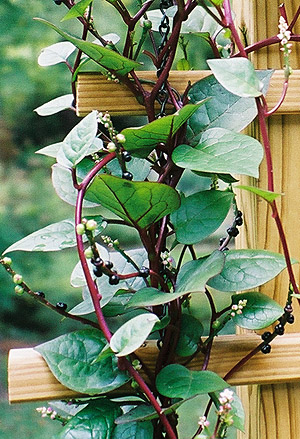Rainfall in East Cobb County GA
Malabar Spinach the
beautiful climbing spinach substitute for the South
not a spinach at all, but really
Basella ruba also Basella alba (light green)
|
|
The heat and humidity in the Southeast make growing real spinach an exasperating
challenge with it rapidly going to seed even when planting the reputedly
heat-resistant Bloomsdale. This colorful climbing plant produces slightly succulent leaves that can be eaten raw or steamed in the same way you might use spinach. It is commonly grown in southeast Asia, India and Indonesia, where in addition to being used in salads, soups and general cooking, it is considered a blood purifier, mild sedative and mood elevator. It is cultivated almost universally in India as a pot herb. The red juice exuded from the stems is used for dye or rouge. This member of the Basellaceae family will tolerate a soil pH between 4.3 and 7.0, so is quite versatile, although it does require some soil moisture and a little shade. Due to the very conditions that prevent satisfactory growth of real spinach, this vine may be attacked by a fungus that causes red-rimmed holes in the leaves. These can be plucked and discarded, but actually do not impact the eating quality of the foliage. In many years of growing this vine, I have never experienced any other problems with insects or disease. To see a photo showing the whole vine on a home-constructed trellis, click here. |
| In our zone 7 garden, the fallen berries that decorate the vines in Fall,
provide more than enough volunteer vines come spring. To
insure plants for spring, tip cuttings can be easily rooted in soil and
wintered over indoors or in a greenhouse. Or, seeds can be
germinated and grown on through the winter. I have not had success
with saving or storing the seeds since they are encased in a fleshy
outer covering that rapidly molds. It may be possible to ferment
the berries for seed extraction as is done with some other fleshy fruit.
Plant out in late spring. Expect a vigorous 10-12' vine that requires support. Watch this vine or it will eat nearby tomatoes, peppers or anything else it can reach. It must be confined by tip pruning or simply cutting off stray vines that reach out of it's allotted space. Lightly pick fresh leaves from the emerging vines to have greens for the table all Summer into Fall. |
|
|
Only two warnings: (1) Beware of emerging seedlings in Spring and thin to prevent being taken over. These thinnings are great in salads. (2) In Fall, take the vines down before the first frost to prevent them becoming a slimy, red-stained mess. Wear old, rubber or latex gloves and work clothes or your hands and clothing will be stained purple. (It washes off.) The safest thing to do with the vines is compost them in place where you want them to grow next year. The pile of vines will decompose through the winter. DO NOT place the seeded vines in your compost pile. |
I have finally been successful in finding a source of seeds. Territorial Seed Company has them listed in the Spring 2010 Catalog. No guarantee that they will have them, but they are listed! |
 Rich in vitamins A and C, iron and calcium, low in
calories, and a rich source of soluble fiber.
Rich in vitamins A and C, iron and calcium, low in
calories, and a rich source of soluble fiber.